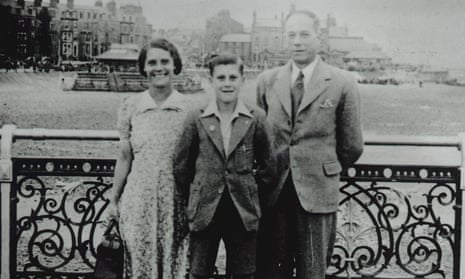Winston Churchill said: “We shape our buildings, thereafter they shape us.” The first building that shaped my future was Manchester town hall, where I started work at the age of 16. The Victorian-Gothic architecture was magnificent – it impressed me then and still moves my spirits today. I spent most lunch breaks wandering around buildings in the city, drawn to them for the aesthetic experience. Some were particularly inspiring – the cast-iron structure of the Barton Arcade, or the modernism of the Daily Express building.
The second was my local library, which was as domestic and homely as the town hall was heroic but, on its bookshelves, I discovered the work of Frank Lloyd Wright and Le Corbusier’s Towards a New Architecture. My imagination was fired by the juxtaposition of timeless buildings from the past next to the aircraft and hydroplanes of the time. Today, more than six decades later, I still find inspiration from the fusion of these different worlds.
I left Manchester town hall at the age of 18 to do national service in the Royal Air Force as a radar technician. My habit of sketching must have caught the attention of the authorities because I ended up designing and painting stage sets for the camp theatre.
Returning home to Manchester I could not face going back to local government, so I did part-time manual jobs, from night shifts baking muffins to working in the local garage and driving a delivery truck. With a passionate side interest in design, I wrote in vain to the leading makers of modern furniture seeking work.
Through a chance encounter, I applied to a firm of architects for a job that was far from creative – it was for an assistant to the contracts manager, who drove around sites checking progress against contractors’ claims for payments. I talked up my town hall experience in the treasurers department and got the job.
The elite in the organisation worked in the drawing office and wore white smocks blemished by countless streaks of black ink from the ruling pens that created line drawings on sheets of crisp linen, dusted with talcum powder.
The youngest of the group was studying architecture part-time at the nearby college of art and his parents were paying the practice for their son’s work experience – a commonplace arrangement at that time. Wanting to start a conversation about architecture, I asked him what he thought about Frank Lloyd Wright. His brow creased as he struggled with the thought and finally asked if I was a student at the college. I then realised that I was more knowledgeable than I thought I was on the subject of architecture and design.

This made me hungry to find out about the profession of architecture. I started to talk more to the men in white smocks. “How do you get into a school of architecture?,” I asked. “You need a portfolio of drawings,” I was told. So I started to create drawings and paintings – the architectural ones were copies of perspectives that I took from the plan chests after everyone left the office, and which I returned before they arrived in the morning. Other works, in gouache, were inspired by one of my hero artists, LS Lowry.
At some point in this sequence I felt a little guilty and decided that I should tell the principal, Mr Beardshaw, about my intentions. I was given an audience and explained that I was going to study architecture. He pointed out that I could not apply without a portfolio. When I told him that I had one, he suggested that I bring it in the next day for him to see.
When I did so, he was completely taken aback. He pronounced that I was “a square peg in a round hole” and I was immediately transferred to the drawing office, resplendent in a white smock.
I finally found myself with three choices. Mr Beardshaw promising me a lucrative design career within his practice – not just in Manchester but in London as well. The College of Art offered me a place on their architecture course, together with a grant to pay for the fees and living expenses.
However, my research told me that the university offered the best course, and with it came a catch-22 situation. Because I had had left school at 16, I did not have A-levels and therefore could not qualify for a degree course. However, the university came up with a solution. If I could fund my own way through university, they would make it possible for me to do the degree course in every respect, but they could not award me a degree at the end. Instead they would give me a diploma. I accepted the offer with gratitude.
It was almost exactly 60 years later that I returned to Manchester Town Hall to deliver the inaugural address of the Royal Fine Arts Trust on the subject of the Northern Powerhouse.
Foster + Partners is running a set of creative projects for children during lockdown called Architecture From Home. Lord Foster is a judge of the upcoming Dezeen Awards 2020
